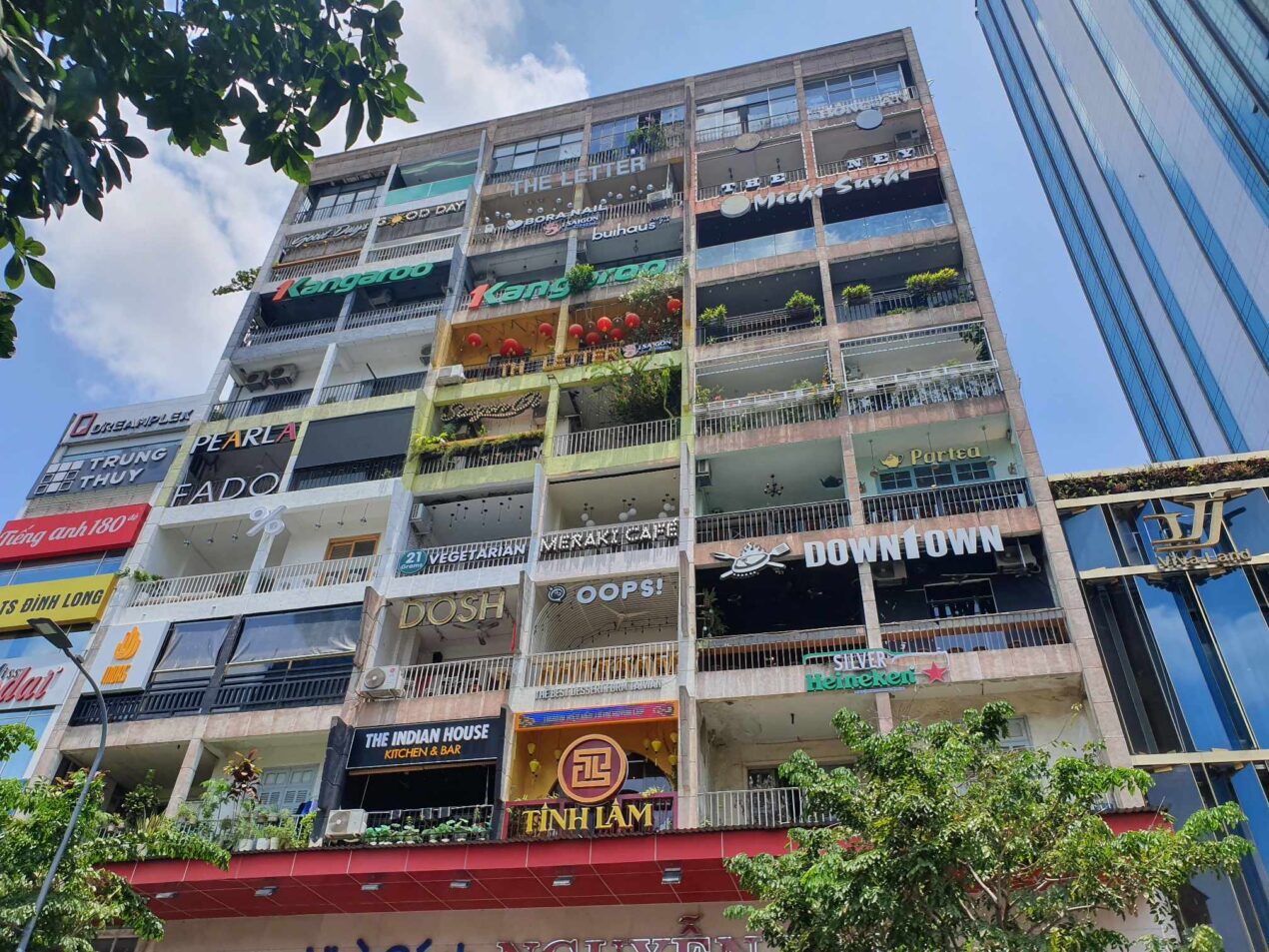27 Pros and Cons of Living in Ho Chi Minh City as a Foreigner
I moved to Ho Chi Minh City (Saigon) on somewhat of a whim, as I was coming hot off the end of a tempestuous relationship and in the throes of great uncertainty as to what my future held (I still am to some degree). I moved with no real foresight or preparation, inspired solely by an offhand comment made by a buddy I knew from Taiwan who had recently set up shop in the city. What piqued my interest was that he couldn’t stop raving about it. With nothing more than my suitcase and absolutely zero expectations (in fact, I was expecting the worst), I hopped a several-hour Eva Airways flight over from Taipei and touched down in the “Pearl of the Far East.”
Little did I know that moving to Ho Chi Minh City would lead to one of the most formative years of my life (from 28 to 29). Since then, I’ve been unable to get enough of the city and frequently go back for extended periods to connect with old friends, slug a few Saigon Bias, chow down on some goat curry BBQ with donkey milk, and recreate that palpable energy and feelings I experienced after first landing.
At this point, it’s a city that is part of my life for good and one that I will always be back to – I can’t wait to see what it has in store for me (and you) in the future.
If you’re considering moving to this vibrant, dynamic, and hectic city, and want to know what I loved and couldn’t care for in the city, here are 27 pros and cons of living in Ho Chi Minh City as a foreigner. For the purposes of this article, I will use Ho Chi Minh City and Saigon interchangeably!
Pale Ale Travel Tip: If you still have questions about living in Saigon after reading these pros and cons, feel free to reach out to me via email and I’ll make sure to answer any questions I can! Or, if you want to know where the various restaurants and cafes pictured below are located, I’m more than happy to answer that as well!
| Pros of Living in Ho Chi Minh City | Cons of Living in Ho Chi Minh City |
Affordable cost of living (including apartment rent) | Limited public transport options and dangerous traffic |
Diverse, delicious Vietnamese cuisine and one of the best coffee and beer cultures in the world | Vietnamese (language) may be difficult to learn |
Large expat and foreigner community with Western amenities | Air and noise pollution |
A safe city that doesn’t get enough credit | Inconsistent and unpredictable visa landscape |
| Easy to travel to other Asian countries | Humidity that is off the charts |
Pro: Vietnamese Food: Saigon is a Gastronomic Oasis
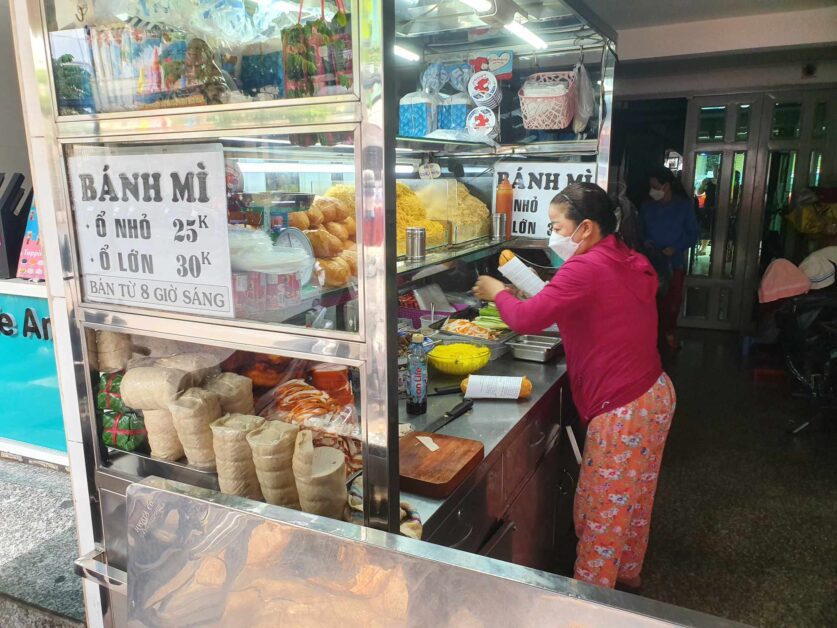
District 4 is hands down my favorite district in the city for food.
How could I not lead with this pro? I think most people who have eaten Vietnamese food outside of Vietnam have walked away from the meal and made a comment to whoever they were with that they could “eat this every single day.” It helps that Vietnamese cuisine is considered one of the healthiest in the world (with the Vietnamese people boasting one of the lowest obesity rates out there) thanks to its abundant use of greens and fresh ingredients, minimal incorporation of protein and fats (with a heavy emphasis on lean proteins), and conservative use of sugar and oil.
Ho Chi Minh City is a melting pot, so expect Northern, Central, and Southern dishes at every corner when you step out of your apartment.
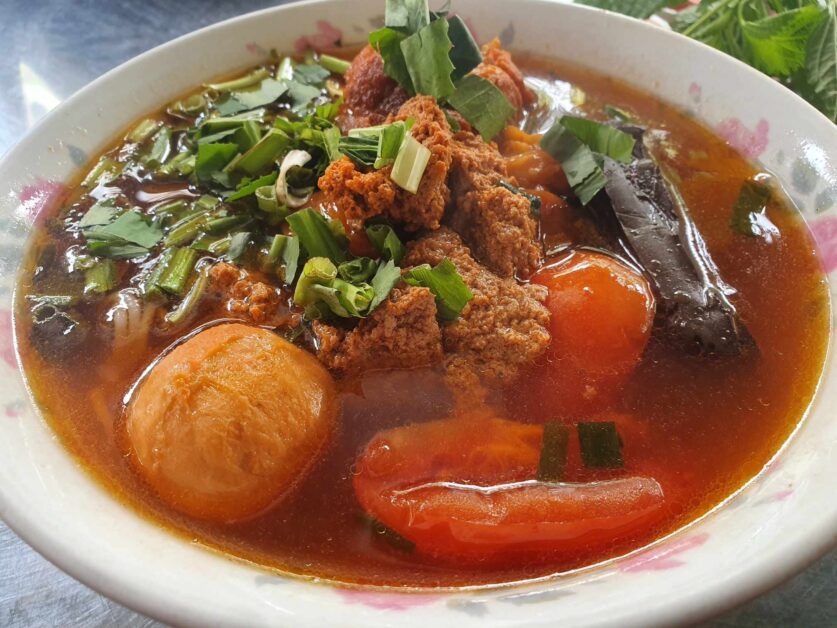
Bun rieu is a popular Northern Vietnamese noodle dish with tomato broth and freshwater crab.
From banh mis consisting of thin, crispy, airy French baguettes with pork pate, cooling cucumber, sour daikon, and carrots, to porky and tomato-ey, salty-sweet bun rieu (a popular Northern Vietnamese noodle dish) and economical broken rice (com tam) with glazed pork and briny fish sauce, to the ever-so-slept-on (by foreigners) Mì Quảng with its flat yellow rice noodles, intense and salty broth, and fresh herbs and crispy, golden com ga (fried chicken) and signature yellow rice, and even the sweet and garlicky snails (oc toi) with crispy baguettes to soak up every drop of flavor, Ho Chi Minh City is a literal culinary mecca.
Oh and of course pho – lots of pho (pho bo – beef noodle soup).
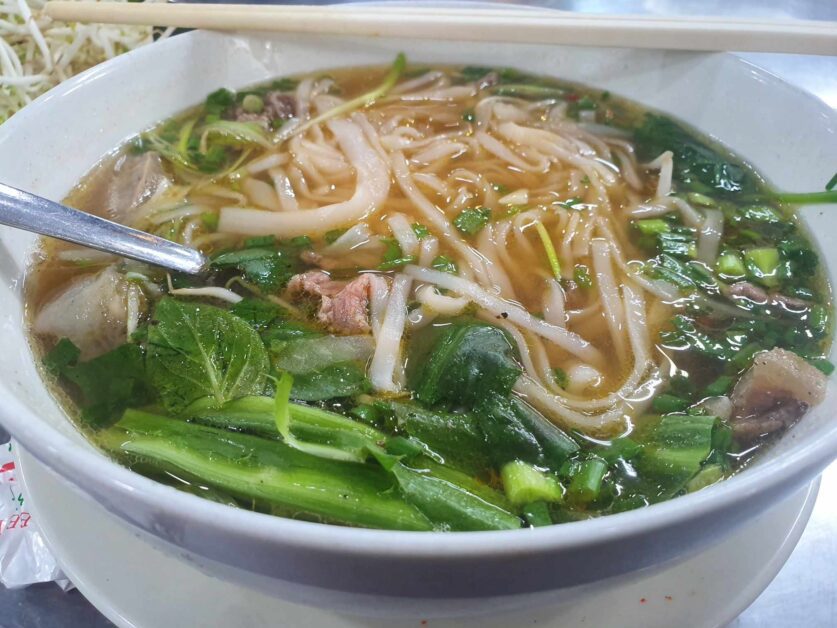
Getting even more granular, you have everything from a vibrant street food culture with countless carts, stalls, and markets, to bustling outdoor BBQ haunts (goat curry BBQ with donkey milk being my favorite) and world-renowned hip, fusion restaurants (I’m looking at you ‘Anan Saigon’), and everything in between. Whatever you’re craving, you can manifest it. This even extends to Western cuisine – including authentic Mexican tacos and classic Italian fare to my favorite, slow-cooked, smoked American BBQ (seriously, some of the best ribs and chicken fried steak I’ve ever eaten were in Saigon).
I have a theory that Vietnam (and Bali from what I hear) is one of the prime spots that experienced Western chefs move to after they’ve run the gamut and put in the long hours at a kitchen back home and now want to do things how they’ve always dreamed.
I would be remiss not to mention that the only restaurants I have ever actually become ill from in Vietnam were Western restaurants that were clearly skipping on health code regulations.
Pale Ale Travel Tip: If you have any particular foods you want to try in Saigon and want a recommendation on where to go, please don’t hesitate to reach out to me in the comments or via email and I will strive to do my best to recommend you a spot or at least point you in the right direction!
Con: You Will Encounter the Occasional Scam or “Foreigner Premium”
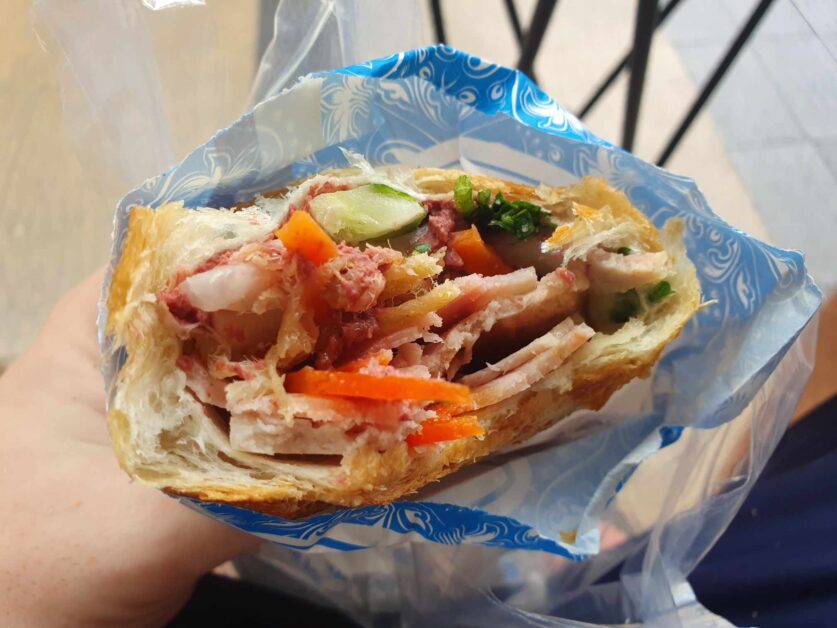
I’ll tell you one thing there’s no foreigner premium on, this banh mi.
As a developing country with a worrying (and unfortunately rising) wealth gap, you may encounter more than a handful of scams or indirect (and direct) taxes and premiums during your time in Saigon. I should preface this with that I do generally find this to be far more overblown online than what the reality is. If you keep your wits about yourself, trust your gut, act deliberately, and apply the same common sense that you would in your home country, then I’d confidently say you don’t have too much to worry about.
The scams and premiums extend to everything from unregulated or unlicensed taxis trying to milk you for extra money (or taking you on circumlocutory routes), to higher priced items and snacks for foreigners (typically with street food or clothing at markets) and quick change scams at local markets or with local vendors (where the large denomination bill you paid with is swapped out with a smaller denomination or fake bill), to cyclo or rickshaw swindles where you’re charged an exorbitant fee for a sightseeing tour around the city, all the way to bar girl scams that involve unconscionably priced drinks (for both you and your drinking partner) and fake police officer shakedowns.
As mentioned above, this is all minor in the grand scheme of things but can become frustrating when you have settled permanently and don’t want to feel taken advantage of or feel like you need to keep your guard up at all points of the day.
A Few Tips to Avoid Being Scammed in Saigon
First, when it comes to taking taxis in Ho Chi Minh, always take a licensed Vinasun, Vina Taxi, or Mai Linh taxi. Familiarize yourself with each taxi’s logo and make sure to step out of the car if there is no meter or they try to tell you that it’s broken. Further, all legitimate drivers should have their licenses displayed in the car and taxi identification numbers on the outside of the car.
Second, when taking a taxi, take a few minutes to research the route via Google Maps of where you want to go (download Google Maps offline if you have to).
Third, for any transaction involving cash, always ensure that you know exactly what bill you’re handing to the vendor or driver (side note: 500,000 notes and 20,000 notes are often confused due to their similarity in size and blue color), memorize or take a picture of the last digits of the serial number (if you have to), announce the amount of the note when handing it to them.
Fourth and finally, in the case of fake police officers who approach you, make up some excuse as to why you’ve broken the law, and request that you pay a fine instead of going down to the station, ask for their identification or simply say, “Sure, let’s go down to the station.” It will become extremely evident at this point that they are not, in fact, “officers of the law.”. For further reading on taxi scams and how to find a legitimate taxi in Ho Chi Minh City, I recommend checking out this article by Innoviet.
Pale Ale Travel Note: During my most recent two months in Ho Chi Minh City, this one woman would drive by my apartment building every day on a motorbike, calling out to me, “Hey, you want my number?” I’d shake my head “No.” She’d throw her head back in laughter like the local poachers in George of the Jungle after Lyle falls in elephant poo, and drive off into the distance. It made me so happy each time and I’m not sure this woman knew the immense joy she would bring to my life every time she’d do that.
Pro: Beer & Breweries Galore
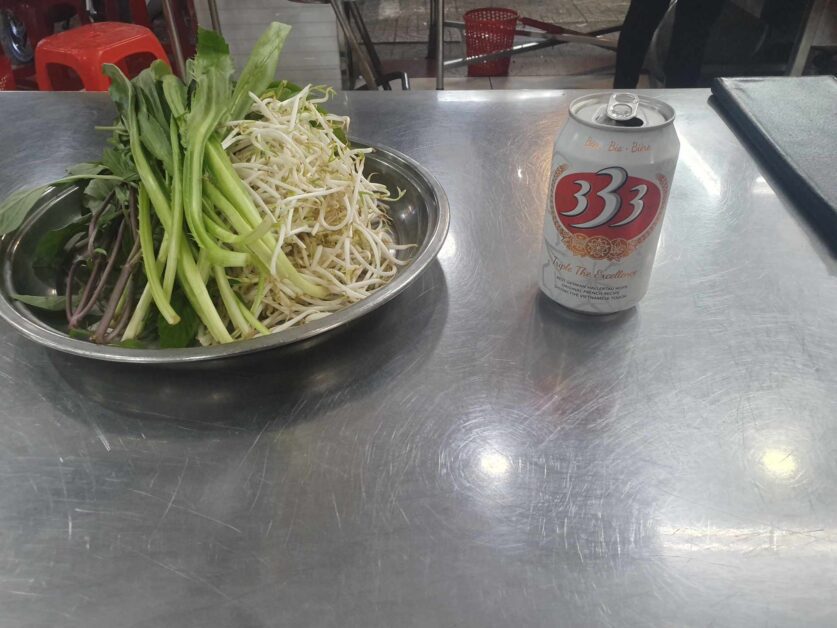
You’re gonna get to know 333 beer very well (“Ba Ba Ba” in Vietnamese).
Show me a better city in Asia for beer and breweries and I’ll show you a liar. Saigon is hands down the number one city in Asia (not even just Southeast Asia) when it comes to creative, robust, and satisfying carbonated adult beverages – both local and craft beer. Not only is there a thriving and established craft beer scene (with Vietnamese flair and flavors) that I would pit against my home state (the craft beer titan – New Hampshire) but Saigon’s local and domestically brewed beer is damn fine as well.
Several of my top breweries – where you can find me at least two or three days of the week (both for grub and beer) – include:
Pasteur Street actually brews up a top five favorite beer for me (ever), their ‘Jasmine IPA’, which I was able to have my local beer shop back in New Hampshire import for several months after I moved back home (many many moons ago).
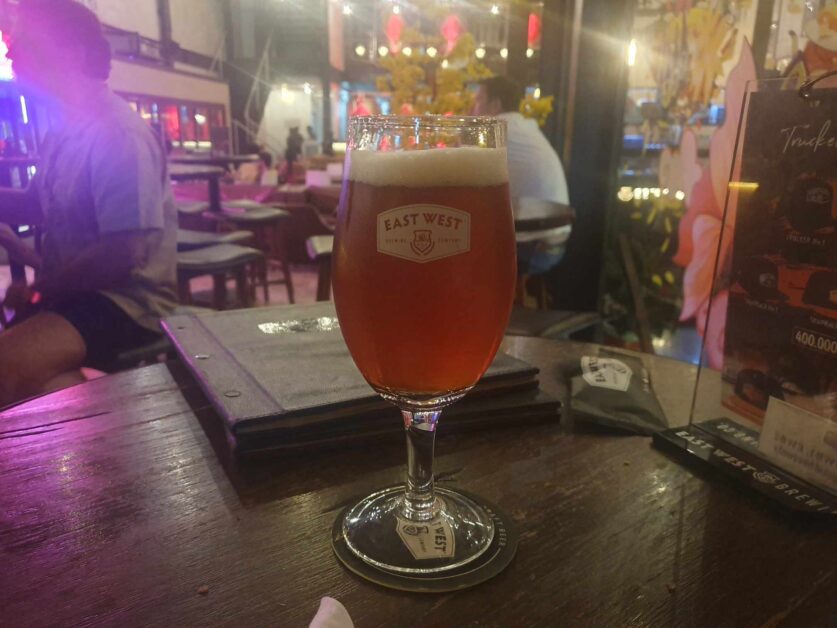
One of my favorite craft beers in Saigon – East West Brewing’s ‘Far East IPA’.
On the domestically brewed beer front, local Vietnamese beer may be one of the most drinkable, flavorful, and robust (besides Japan) that I’ve encountered in Asia – just be ready to pour it over a glass filled to the brim with ice (this took me a bit to get used to after moving here). The positive is that you will stay hydrated while drinking. The negative is that you literally have no idea how many beers you consume in a night because of how easy it is to finish the glass in one fell gulp.
My personal Saigonese favorites include 333, brewed by Saigonese-based Sabeco Brewery, and the ever-so-popular Saigon Beer (I’m a premium red boy over green label). Order them by the bucket (or by the can is fine as well) and kick back for a long, liquid-courage field night with your friends at a local BBQ or snail haunt.
Pale Ale Travel Tip: Speaking of such, if you are in Saigon and looking to get your fill of bitter and citrusy IPAs, flavorful pilsners, and warhead-esque sours, make sure to check out my self-guided craft beer pub crawl or post breaking down my top breweries in Saigon.
Con: Traffic Can Be Dangerous & Comically Insane
Having an estimated 10 million registered vehicles in the city (both motorbikes and cars), Saigon traffic may be one of the more hectic things you’ll come across in your life. It’s not unsurprising to encounter intersections with no traffic lights or stop signs (where vehicles blow through them with no regard for human life), motorbikes (by the dozen) driving up on the sidewalk in broad daylight, a complete disregard for turn signals or common sense, and traffic jams so jumbled that it takes a miracle for the free flow of traffic to resume.
While Ho Chi Minh City is safe in the crime context (but for petty theft and bag snatching), traffic is definitely one of those dangers that you do need to be mindful of and exercise a certain degree of caution with (whether it’s driving yourself or simply crossing the street). What I’ve found is that there is somewhat of an unspoken order and code when it comes to navigating the chaotic traffic in Saigon where if you drive and/or move with purpose and avoid making sudden, unpredictable movements, you (generally) shouldn’t encounter too many issues.
Remain steadfast in your direction, speed, and movement, and all should be ok. This can be difficult to do when encountering your first intersection or road that needs crossing and it’s inevitable that your heart will pound as you enter into a game of real-life Frogger. I have some friends who become absolutely paralyzed with fear when it comes to crossing the street or driving and generally avoid stepping foot outside unless necessary, and I have others who embrace it full-on and definitely err on the side of reckless when it comes to racing their souped-up bike around the city.
Unfortunately, the smooth and safe flow of traffic is just one of those things that isn’t looking like it will be fixed anytime soon, so it’s incumbent on you to take some preventative and cautionary measures to protect yourself (getting a helmet is a great first start if you plan on owning or renting a scooter).
Pro: One of the Coffee & Cafe Cultures in the World (If Not the Best)
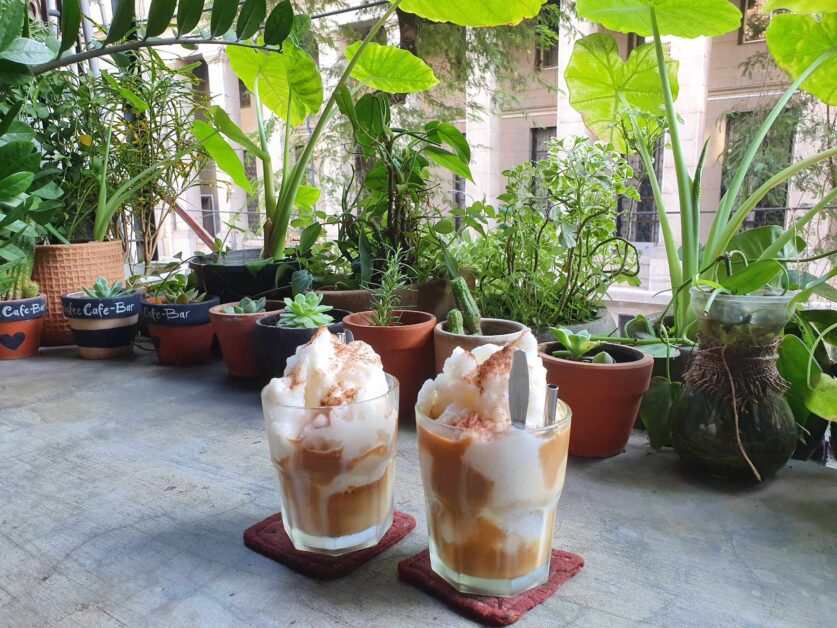
Vietnamese iced coconut coffee might be one of the G.O.A.T. (greatest of all time) coffees out there.
Vietnam is the number two largest exporter of coffee in the world, with an estimated global market share of just under 15%. The Vietnamese are serious about their coffee. And because of that, it has produced one of the best coffee and cafe cultures in the world (possibly the best). From the second you get up to before you go to bed, you’re going to find a coffee shop, stall, or local vendor brewing up a batch of strong, bold, dark roast (with condensed milk or with coconut milk if you so desire).
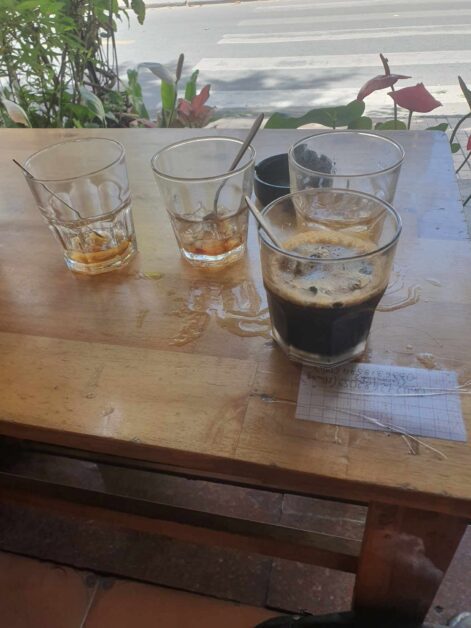
Every now and then, I’ll just push it to the limit and get wired to the gills off black coffee.
Ho Chi Minh City is incredible in the way that there are coffee shops and cafes of all shapes, sizes, and themes located in every crevice of the city. From the iconic and multicolored ‘Cafe Apartment Building’ located on the bustling Nguyen Hue Street (the featured image of this article) in the city center with dozens of various themed cafes and shops, to secluded (and hidden) French antique tea rooms and cafes serving up bite-sized sandwiches and espressos (and fantastic teas of course), all the way to laptop-friendly haunts to knock out some work while sipping a potent cold brew and popular chains mixing up rich and creamy frozen coconut coffees (pictured above), I’m not even sure you could dream this many different types of cafes if you sat down and tried.
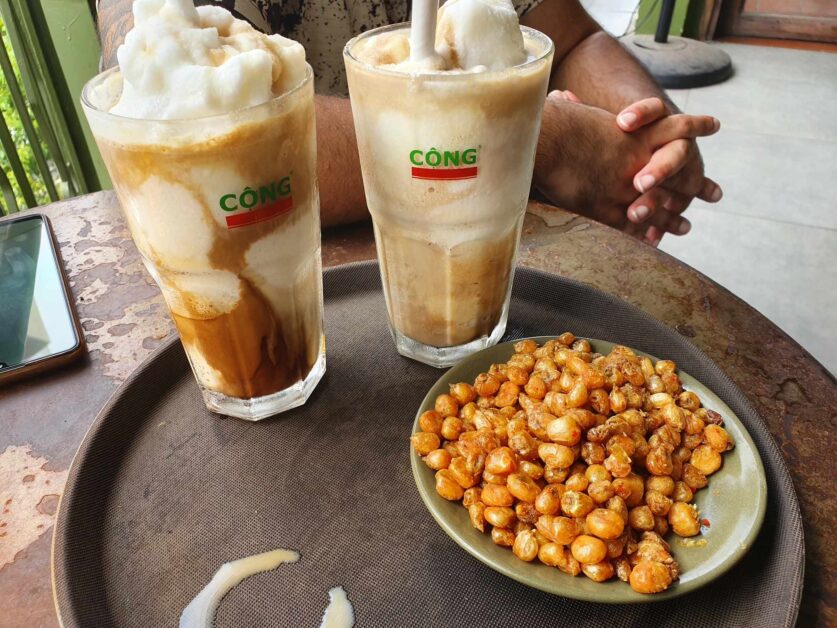
You can’t go wrong with a coffee from Cong Caphe (which you can find all over the city).
When I say the coffee is strong, I mean it. I’ve never been as wired in my life as I am after a few black coffees in this city. Some of my best memories in Saigon are meeting friends late-night to sit outside on plastic stools, along with hundreds of other coffee enthusiasts and late-night socializers, while throwing back hypercharged iced Vietnamese milk coffees (ca phe sua da), mixed corn nuts, and assorted snacks (ex. Mango wedges with shrimp salt – don’t knock it until you’ve tried it). This is a classic Vietnamese pastime.
Saigon’s coffee and cafe culture is one of the driving reasons why I fall more in love with the city every time I return, as there are hundreds (if not thousands) of these hidden (or not-so-hidden) spots to indulge in, post-up with your friends, and lean into what it means to be Vietnamese (celebrating a communal, relaxed, and jovial activity – sans hangover).
Con: Lack of Metro & Public Transportation Isn’t the Best
Frankly, public transport is lacking in Ho Chi Minh and I would emphatically state it is not the primary method for foreigners to commute and traverse the city. In an Internations survey analyzing the quality of urban living amongst expats, a mere one in four Ho Chi Minh expats rated the city’s public transportation and infrastructure positively – a stark contrast to several of its ASEAN neighbors such as Thailand, Singapore, and Malaysia.
Ho Chi Minh City does sport a robust network of varying bus routes which costs anywhere from several thousand dong to ten thousand-plus (depending on the distance) – it’s a very affordable way to get around the city. However, the core problem you’ll run into is that most municipal bus routes will cease for the day around 6:30 PM, with several later running buses halting operations for the day at 8-8:30 PM.
And, while the metro will likely never be built in my lifetime (due to an array of financial hiccups such as lack of payment to contractors, the several-year-long pandemic, and numerous technical snags), rest assured that the city is relatively easy to traverse – all thanks to Grab and motorbikes. Most areas of Ho Chi Minh City are easily accessible via Grab or motorbike and you’re never really more than a 30 to 45-minute drive from where you want or need to be.
If you do move to Ho Chi Minh City for the long term, I recommend renting and/or purchasing a motorbike which can be done for just several hundred USD. This is going to be your prime way to navigate the city. If you don’t trust yourself on a bike like me, then sticking with Grab cars or Grab bikes won’t steer you wrong at all.
So while public transportation may be listed as a con, I’d argue that you really aren’t going to run into any major transportation hurdles while traveling to or living in the city.
Pro: Affordable Rent & Apartments
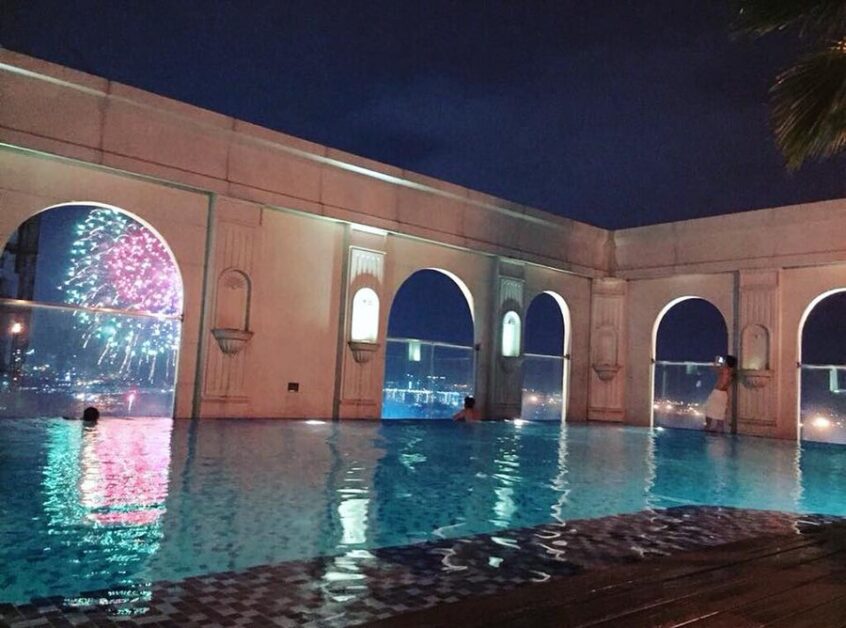
A shot of the rooftop pool at my apartment in Saigon.
If you’ve read any other posts on this blog, then you may know that I’m based in Hong Kong – one of the most expensive cities in the world when it comes to renting and owning an apartment. Ho Chi Minh City may be one of the best bang-for-your-buck deals anywhere I’ve encountered during my travels and living when it comes to renting an apartment.
On the lower end, you can reasonably find a furnished studio apartment, within a 10 to 15-minute Grab or motorbike ride from the city center for roughly USD $200-250 (you can go even cheaper with a more barebones spot as well). Luxury apartments and higher-end housing estates and complexes, complete with Western amenities like pools, gyms, supermarkets, and more, may run you anywhere from USD 500 (as a starting price) to USD 1,200 for a large studio or one-bedroom.
Should you find a roommate or two, prices can significantly decrease when it comes to splitting the cost of a two to three-bedroom in a Western-style or luxury apartment complex.
One major note is that apartment rentals are exponentially more affordable when you negotiate a long-term contract. For reference, I lived in a “luxury apartment” building in District 4 – less than a 10-minute walk from Nguyen Hue Street and Bitexco in District 1 – and was able to negotiate a one-bedroom for one year for USD 750 per month. When I returned to Ho Chi Minh for a two-month stint in 2023, I stayed in the same building and paid nearly double that (USD 1,500).
Pale Ale Travel Tip: If you’d like to read more about it, make sure to check out my post ‘How much does it cost to live in a luxury apartment in Saigon?’. Also, one of my favorite memories is when I first rented my apartment, the agent had a woman show up on her motorbike with a jailbroken debit card reader that looked like some sort of IED and wanted me to swipe my card to pay the two months deposit. They were confused when I said that there was absolutely no way I would do such a thing and I simply sprinted over to the nearest Citibank instead.
Con: Pollution Can Be Rough
Having previously lived in Beijing and Shanghai, I can tell you that while I wasn’t nearly as affected by Saigon’s pollution during my one-year stint there, it still isn’t to be celebrated. According to WHO annual air quality guideline standard, PM2.5 concentration (fine particulate matter that infiltrates the lungs and respiratory system) is nearly 7 times the recommended limit (as of the date of publication).
This isn’t really a surprise with the amount of vehicles that can be found on the road at any given time – both cars AND motorbikes. As of 2022, there are an estimated 7.3 million-plus motorbikes in the city, which is an astronomical sum considering that there are just under 10 million registered residents living within the city proper as of 2023 (with countless more coming in for work, travel, and other reasons).
Vietnam as a country ranks as one of the top 30 worst countries for pollution in the world, after China, India, and Bangladesh, and before South Africa, Turkey, and Sri Lanka. However, transportation isn’t the only driving factor behind these abysmal air conditions – solid fuel burning, poorly thought-out urban planning, and countless manufacturing plants scattered across the city (and surrounding area) all contribute to a less-than-ideal environment.
Having lived in Ho Chi Minh City in 2018 and 2019, I can attest to the fact that the Vietnamese were wearing face masks long before it became “cool” during the pandemic – and this was primarily due to the pollution of motorbikes. I remember sitting on the back of a motorbike of the woman I was seeing at the time and by the end of our 45-minute trip across the city, it felt as if I had smoked two packs of cigarettes and one ashy shisha in a single sitting.
Pro: Affordable Cost of Living
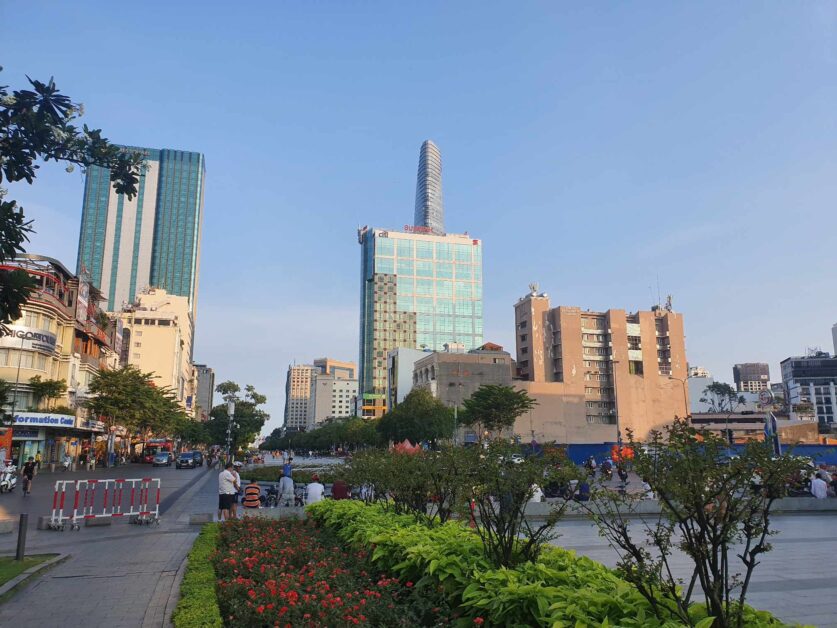
The aforementioned Internations survey on expat quality of urban living found that the top draw for foreigners in the city – nearly 80% of them – was (and is) Ho Chi Minh City’s cost of living. Saigon is regularly cited as one of the most affordable cities in all of Southeast Asia – just after Kuala Lumpur – with average monthly costs clocking in at roughly USD 820 (including rent). Further, one 2022 survey by expat insurance powerhouse ‘William Russell’ found that Saigon living costs come in at nearly 65% lower than the United States and 45% lower than that in the United Kingdom.
My goal in Saigon is to keep spending under 1 million dong per day (roughly USD $40). This includes coffee, transportation, lunch, and dinner. I do have plenty of friends (Western and local) in the city who also can get through the day for VND 200,000 (USD $8). Saigon is one of those cities where it can be as affordable or expensive as you want it.
Of course, if you find yourself eating at one of the many fantastic Western restaurants, this can easily add up and you can see days running well above VND 2,000,000 (USD $80). Or, you can snag a delicious banh mi on the street for around VND 12,000-25,000, grab a caphe sua da for about the same (or a bit less), and a fresh, herbaceous bowl of pho, bun bo hue, or Mì Quảng for dinner for VND 50,000-plus, and keep costs well under the 200,000 (or even 100,000 mark).
A final note is that I would caution people against taking numbers on the cost of living comparison sites like ‘Numbeo’ and ‘Expatistan’ as doctrine and instead as a starting point and/or range.
Pale Ale Travel Tip: If you’re curious about some daily, weekly, and monthly costs you could expect as a foreigner living in Ho Chi Minh City, make sure to check out my post ‘How Much I Spent Per Week in Saigon’.
Con: A Relatively Volatile & Inconsistent Visa Landscape
I do understand that I am likely contributing to the issue of “working” and existing in a “gray” area during the times that I’ve lived in Saigon, as I did not have a traditional work visa – and instead relied on one-month visas which I would renew with a quick trip to Cambodia or Thailand and back. At the time (2018-2019), this was relatively easy to do and a painless process, with visa renewals costing anywhere from USD $40 to $100 per month – depending on how quickly I needed the visa expedited.
However, when I returned to Saigon in 2023, with pandemic restrictions and entry requirements still lingering, Vietnam was in the midst of only issuing one-month visas. This put my 2023 travel plans into a bit of a funk as I intended to stay roughly three months before heading elsewhere for the remaining three months outside of Hong Kong. Because of this, I broke it up into one-month stints (January and March) and ultimately moved to Japan for the remaining three months due to the clearer and more straightforward entry process.
Do understand that whatever timeline you think will happen for bureaucratic efficiency will happen far slower than you thought – and that was on me for being so naive. For those who intend to seek employment from a traditional Vietnamese or international company based in Saigon, the process is somewhat rigid and you will need your employer to apply on your half – but at least you won’t exist in the perpetual gray area.
Pale Ale Travel Tip: I actually wrote about one of my visa runs to the Moc Bai border into Cambodia, which you can read more about in my post ‘Visa Run: Ho Chi Minh to Phnom Penh Bus Ride’.
Pro: Bustling & Thriving Nightlife
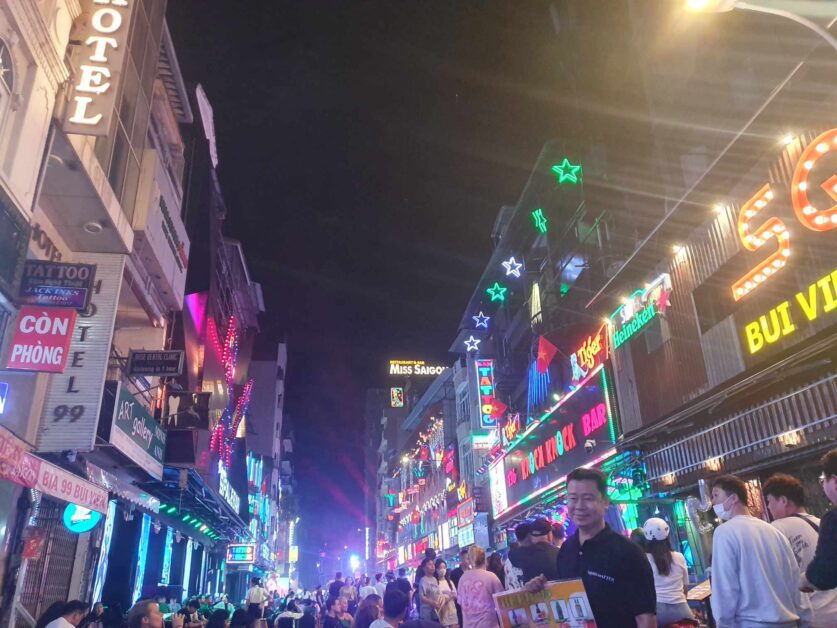
Bui Vien Walking Street is a literal assault on all senses (in both the best and worst ways possible).
Having moved to Saigon from the tranquil, comfortable, and predictable Taipei (I still love you though Taiwan), I described my new home to a friend as the “Mr. Hyde” to Taipei’s “Dr. Jekyll.” I had never felt more alive than when I first moved to Saigon. I still feel pings of this every time I return – and a major contributing factor is the city’s 24/7 nightlife.
If you’re a fan of vibrant rooftop bars with creative cocktails and DJs spinning lo-fi and electro into the early morning or chilled-out breweries and craft beer bars serving New England-style IPAs and Belgian wheats, you got it. If you want to get down and dirty on some plastic stools with a couple of tins of 333 beer and balloons, that’s never more than a stone’s throw away (say hello to ‘Bui Vien Walking Street’).
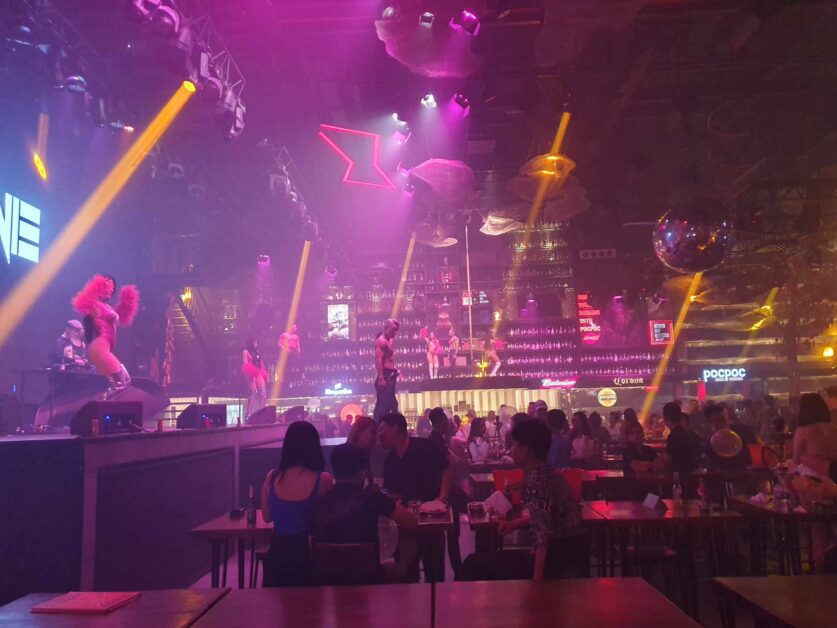
One of the shirtless male dancers looked at me so I popped off my shirt and pointed at my belly. He smiled and nodded in approval.
If you want to shake your money maker in a club (no, not the type of club that the rapper T.I. has spent half of his adult life in Atlanta) and order lavish bottle service, this is your city. Or maybe, you’re more of a “smoke some 6 PM shisha” while listening to deafening bass at a beer garden (looking at you ‘Poc Poc Beer Garden’), that’s on the docket as well. And if you want to rent a decked-out private room to partake in party favors with several of your closest friends in a safe space, I’ve heard rumblings that this exists.
Some might argue that there’s a little too much fun, hedonism, and excess to be lived in Ho Chi Minh. However, if you live there long enough, you’ll learn to manage it (or maybe you aren’t as susceptible to vice as this Big Body to begin with).
For example, I obviously hit it relatively hard my first several months in the city as I was reunited with several old friends who have a penchant for the debaucherous and spectacle. But after getting that out of my system (by “that” I mean party balloons and Tiger beer towers), I think I would then average returning to ‘Bui Vien’ and the more lecherous areas of Saigon once every three or four months after that – typically when a friend or two would visit.
Pale Ale Travel Tip: If you’re a sucker for a beverage with a view like me, then make sure to check out my post on the top rooftop bars in Saigon. And, if you’re curious on Vietnam’s alcohol laws, make sure to check out my post explaining the ‘Legal Drinking Age in Vietnam‘.
Con: Trash Everywhere
Environmental consciousness and sustainable infrastructure (ex. Recycling) still has a long way to go in Saigon (and Vietnam as a whole) before it’s anywhere close to being on the right track toward a sustainable eco-footprint (then again, this is an unattainable reality for most countries out there). A flagrant disregard for trash disposal is immediately noticeable upon entering the city – whether it be the actual lack of garbage removal services or the average person tossing their trash on the side of the road.
For a city of 10 million, it might surprise you to read that there is actually NO official garbage or trash system to collect, repurpose, and dispose of it at a designated location. This results in a city that at points can smell…well…unpleasant. Then again, I’m not the greatest-smelling person myself so maybe I don’t have a leg to stand on here. It can also result in some aesthetically undesirable scenes as well. I don’t think anyone wants to see piles of garbage stacked like Jenga blocks on the side of the road.
This is not a knock to the Vietnamese people at all. Rather, it’s just something that isn’t (and hasn’t been) at the forefront of their minds and I do think there is a lack of education about the effects of littering – especially with the older generation. Frankly, there were more pressing concerns over the years, such as war and food insecurity, that undoubtedly needed to be resolved (or improved) before attempting to remedy such a problem.
Pale Ale Travel Note: I don’t know if it’s hilarious or horrifying but the building management at my apartment did have to put up signs all over that read, “Please stop burning trash inside.”
I would be negligent not to mention that the times are changing, especially with the younger generation, and upon my most recent return, I did notice a far more environmentally conscious attitude towards littering. So while you may encounter piles of trash on the side of the road, or clogged rivers with garbage, and more than the occasional passerby just throwing whatever finished item they hold in their hand on the ground, I’m overall optimistic about the future of an effort towards environmental sustainability (or at least better than what it was before).
Pale Ale Travel Anecdote: To sum things up about how certain ideas that we hold as normal in other parts of the world really aren’t approached the same way elsewhere, every day I would walk across a little footbridge from District 4 to District 1 (across the Ben Nghe Channel that feeds into the Saigon River) and there would be garbage everywhere in the water – so much so that there was no clear flow of water. Like clockwork, every week there would be a group of teens who would swim in it and just have an absolute blast horsing around with one another, jumping in, and swimming. To them, this is just how life was.
Pro: A Safe City That Doesn’t Get the Credit It Deserves
In the lead-up, before I moved to Saigon, I naively went online and began reading about the crime in the city. I have to say, there was a lot of fear-mongering online, and what ultimately (based on my personal experience) I feel to be overblown paranoia. While Saigon is an absolutely hectic, volatile, and bustling metropolitan, I’ve never felt unsafe here at all – and I’ve gotten into some less-than-savory and strange situations. I even live(d) in District 4 – and continue to stay here when I return – a district once notoriously labeled the most dangerous district in Ho Chi Minh City. This was due to the notorious Vietnamese mobster Năm Cam making it his headquarters and the district being a bit rougher around the edges due to its dense population and large influx of migrants from elsewhere in Vietnam.
Saigon is considered one of the safest cities in Southeast Asia where violent crime is minimal (especially against foreigners). A 2023 study by Numbeo ranked HCMC as a top 20 safest city in Southeast Asia (just several spots down from Hanoi) based on user-contributed feedback and data – in the context of perceived AND actual safety of walking alone during both the daytime and nighttime.
As I mentioned above, when it comes to personal safety, your biggest worry should be crossing the road or driving a motorbike. This is not to say that you shouldn’t take regular precautions as you would in any other city. You should absolutely do that. Always remain aware of your surroundings, do not flash or wear fancy jewelry on the street, be mindful and deliberate when crossing the street, and if something “feels off” then trust your gut.
As someone who carries a backpack around with me to most places, I make sure that I have a tight grip on it, walk with it on the inside of the road, and avoid leaving it unattended. I do want to note that I’ve never had any attempts at snatching my bag or personal belongings in my year-plus living in the city – and I’ve brought my bag and personal belongings with me for several benders on the hedonistic Bui Vien Walking Street.
Con: May Not Be as Beautiful & Tranquil as Other Parts of Vietnam
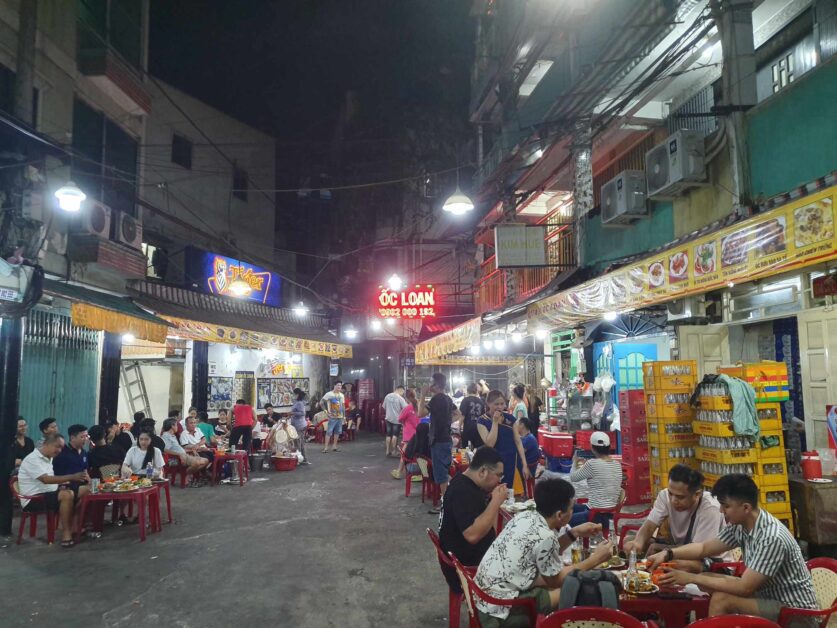
For me, the beauty of Saigon lies in these back alleys (Oc Loan – a popular garlic snail haunt in District 3)
Aesthetically, I can’t say that Ho Chi Minh City is one of the most beautiful cities I’ve ever lived in or traveled to. However, I do believe there is undeniable and unquantifiable beauty that exists in the back streets, the little nooks and crannies of the city, and in the collective effervescence of communal activities (ex. Coffee culture). The beauty of Saigon just takes a different form than what you might be used to seeing.
While rapid urbanization and overcrowded districts, a general lack of open parks and other green spaces, slight remnants and dilapidated buildings from the war, traffic pollution and congestion, and lack of cultural heritage preservation, the city still takes my breath away when I step out on the footbridge connecting District 4 and District 1 or when I find myself wandering down a back alley in search of the strongest coffee of my life. The beauty is in its imperfections – and there are many (but that’s a compliment).

A view of District 4 and District 1 from my apartment.
If you are looking for more traditionally picturesque, serene landscapes, monuments, and other environmental wonders, this likely isn’t the spot. For that, look to Sapa’s ethereal terraced rice fields, Danang and Nha Trang’s (also Phu Quoc) sandy beaches, Hoi An’s ancient town pagodas and beautiful Chinese silk lanterns, or Mui Ne’s white sand dunes.
Some of my favorite sites in Ho Chi Minh City include walking across the small footbridge between District 4 and District 1 at sunset and looking up in awe at the towering, lit-up Bitexco Financial Tower, heading to Nguyen Hue as the night begins to look up at the yellow, illuminated French colonial city hall (the People’s Committee of Ho Chi Minh City), sipping a coffee from one of my favorite cafes and restaurants ‘Au Parc’ which overlooks a green, vibrant park (and is a stone’s throw away from the Independence Palace), and tossing back a cocktail or seven atop one of the hotels overlooking the Saigon River.
Pro: Large Expat Community
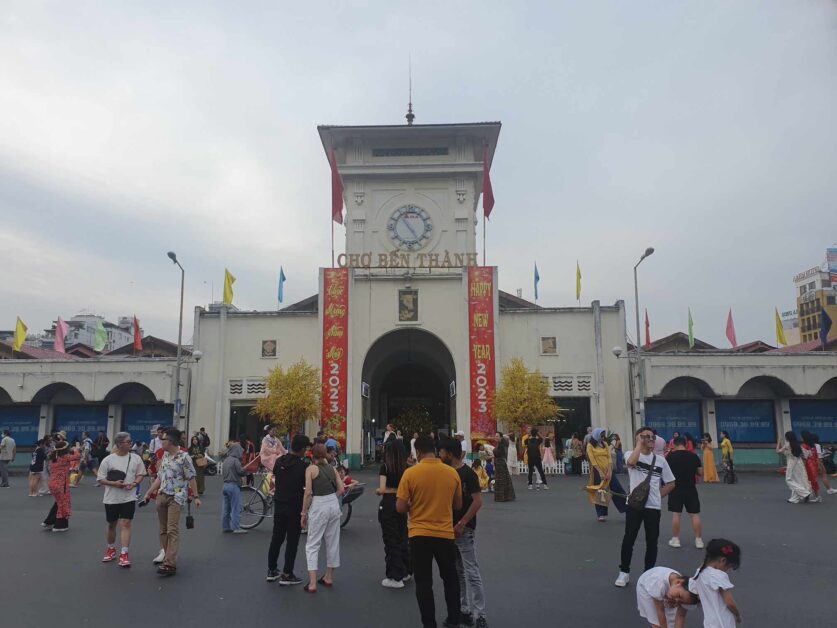
Ben Thanh Market is District 1 is a popular spot for both foreigners and locals alike.
Depending on what you are looking for in a country, this could be a positive or a negative. But then again, as mentioned above, Saigon (and Vietnam) can be whatever you want it to be. If you only want to speak Vietnamese and eat locally, you can do that. If you want to only eat at Western chains or breweries and socialize with expats and backpackers who come through the city, that’s also a viable option. If you’re like me and like to exist somewhere in the middle (sans the Vietnamese language skills), then that’s more than possible.
While I’m unsure of the exact number of expats and foreigners officially living in Ho Chi Minh City, there are an estimated 100,000 expats living in Vietnam – according to the Ministry of Labor’s 2021 data – with the majority concentrated between Hanoi and Ho Chi Minh. With a large expat and foreigner community comes certain Western and foreign luxuries, attitudes, and amenities, which Ho Chi Minh is replete with.
There are even “expat enclaves” out in Thao Dien (District 2) with gated (and barbed wire) communities, private clubs and sports academies, high-priced international schools, and resorts (with speedboats to take residents into District 1). This is a popular area where expats on high packages, politicians, and celebrities are found making their residences
And it’s not just expats who live and work in the city – foreigners visit the city in droves (it has dropped off somewhat substantially since the Covid pandemic and Vietnam’s inconsistent and short-term visas until somewhat recently), with an estimated 7 to 8 million visitors passing through the city each year. So there is always a familiarity level and baseline that exists in HCMC when it comes to seeing foreigners around (and interacting with them).
Con: Cash-Driven Society
As someone who has needed to pay off some credit card debt at points in my life, maybe this isn’t actually a terrible thing. It’s worth noting that Saigon (and Vietnam) is a cash-driven society so you may find yourself making frequent trips to the ATM. While all major credit cards are accepted at most Western restaurants, stores, and malls, your everyday interactions will take place in cold hard Vietnamese dong (VND).
In fact, the overwhelming majority of all financial transactions in Vietnam take place using cash as the lack of digital payment infrastructure that you may be used to in your home country still leaves a lot to be desired. This may be due to the fact that an estimated 60% of the country’s population still receives their salaries in cash, the fact that there is no major digital payment disrupter who has truly permeated the market, or a general distrust for banking and governmental institutions amongst the Vietnamese people.
If you’re traveling to Ho Chi Minh City, I recommend that you:
- Exchange significant sums of cash for VND before arriving,
- Use one of the more affordable currency exchange booths (not at the airport!!!), or
- Pick up a zero international fee debit card or zero withdrawal fee debit card like Charles Schwab – this is what I primarily use – mixed in with some random Bitcoin purchases and withdrawals.
Pro: Plenty of English Teaching Jobs
Vietnam is hailed as one of the best countries for English speakers to move to teach English. It doesn’t pay half bad either. In fact, it pays quite great and above market rate (compared to other ASEAN countries like The Philippines or Thailand). Salaries may range from USD 1,000 to USD 2,500 per month – roughly 25 million to 60 million dong per month – with teachers commanding even more at some popular international schools.
From public schools to small, general tutoring centers or specialist centers to IELTS testing schools and renowned international schools and universities, there’s no shortage of English teaching positions in Ho Chi Minh (and Vietnam). Most schools require that a teacher come licensed and have a verified teaching certificate such as a TEFL, TESOL, or TEFL. For non-native English speakers, you may need to provide an IELTS or TOEFL certificate of completion, with a specific score to be considered for the position.
I recommend anyone considering moving to Saigon or Vietnam who is intent on teaching English to actually acquire a license or teaching certificate before doing so as there is already a fair share of foreigners teaching English under the radar and without the requisite qualifications.
Con: Noise Pollution (Inside & Outside)
Noise pollution is cited as one of Ho Chi Minh City’s biggest overlooked environmental concerns and a somewhat pernicious (or maybe acute?) phenomenon carrying far more damaging consequences than one might expect – including heart failure, high stress, and diminished learning.
Whether it’s a horde of local teenagers sitting outside a coffee shop into the early hours drinking bubble teas and iced coffees, the engine revving and horn blaring cacophony from thousands of motorbikes, or early morning rooster calls and neighbors who have no problems letting their animals bark for hours on end, Saigon’s noise pollution can definitely take a toll on you – especially if you’re someone looking to get into a zen-like state or conduct your daily affirmations in quiet. Maybe I’m a bit of a masochist but I kind of love and hate this con at the same time. It means that there is always something going on in this city, which is inevitably going to generate some form of noise. So to me, it’s more of a byproduct of a thriving and bustling city.
Recently, when I was back in Saigon for several months and staying in my old apartment building, I was awoken every morning by the incessant barking of the dog next door. I was confused as the apartment complex has clearly labeled signs everywhere prohibiting animals in the building (in Vietnam, that’s loosely enforced). I knocked on my neighbor’s door and asked him to please be mindful of his dog and the noises, to which he responded, “I don’t have a dog.” As if on cue, the dog began barking and I gave him the Larry David “up and down” look. Ultimately, the issue wasn’t resolved and I ended up changing floors at the apartment for some peace and quiet.
Pro: Easy Access to Almost Anywhere in Asia
Why I’ve settled permanently in Hong Kong is due to its proximity to everywhere else in Asia. I value being able to pick up and go and be at a destination within several hours. Ho Chi Minh City is similar. This city is an absolute hub when it comes to being able to easily travel to almost anywhere in Asia within a reasonable timeframe. This means that weekend trips, extended holidays, or even multi-location excursions are at your fingertips.
Need convincing that you can travel to countless other Asian destinations within five hours? Check out this site – for reference, I was able to travel to Osaka (where I lived for three months) in five hours flat, Bangkok in just over one hour, Singapore in two hours, Hong Kong and Taipei in roughly three hours, and Phnom Penh in 55 minutes (via plane). Even Western India and Korea are within reach and under five hours by flight.
Ho Chi Minh City isn’t just convenient for international flights either. You can access almost anywhere in Vietnam (by plane) within two hours. Flights to Hanoi from Saigon are 2 hours on the nose. For budget traveling (or if you just want a scenic view of the country), Vietnam’s 2,600 km long railway will get you most places you want to be in anywhere from 10 to 40 hours. There are also numerous private buses and cars for hire that will take you to the Cambodian border or elsewhere in the country (including Vung Tau – which is just to the southeast of Saigon).
Several buddies rave about (and I wholeheartedly agree) the ease by which and time you can get into the heart of Saigon from the airport. From touchdown to the city center, you can be there in under an hour (including immigration, customs, and picking up a SIM). This means weekend trips outside the city or country may seem less daunting knowing that you don’t spend half of it commuting to the airport or returning home.
Con: Vietnamese Can Be Difficult to Pick Up
Vietnamese is spoken by an estimated 85 million people worldwide and is split into three core dialects: North, Central, and South – all with varying vocabulary, pronunciation, and nuance. It’s grouped in the same language difficulty category as Russian, Urdu, and Hebrew, and considered a “category four” (on a five-tier scale ascending in difficulty) language by the US Foreign Service Institute (FSI). In simple terms, it’s categorized as a “hard” language primarily due its tonal nature (6 tones), its high number of vowels, difficult pronunciation, and rapid speech patterns.
If you’re a language person then learning Vietnamese could be the perfect challenge for you to take on. If you’re like me and already burnt out from years of Mandarin study (and a short stint with Cantonese) and simply planning on focusing on work or travel, I’d emphatically say that you should have no problem with everyday life. Just be prepared to use Google Translate if needed or take cues from your closest Italian friend on how to properly explain highly esoteric and complex concepts with hand gestures and grunts.
I do have to give props to one of my favorite YouTubers to watch – Phúc Mập – a red-haired, thirty-something guy from Florida who is based in Saigon and has put in a lot of thoughtful study with the language and his celebration of the Vietnamese people, culture, and city is a beautiful thing to watch.
Pro: A Rich, Powerful, & Resilient History
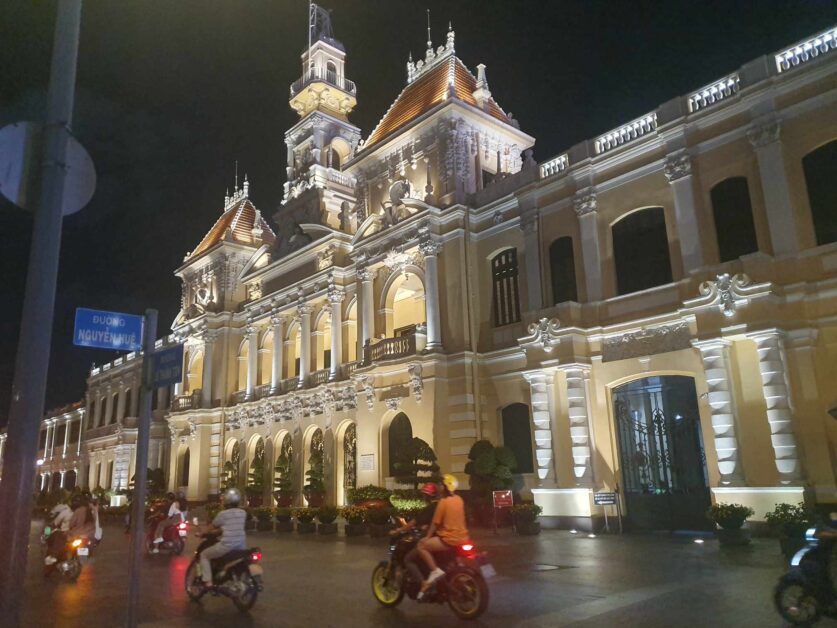
Formerly an outpost and territory of the Kingdom of Cambodia and referred to as ‘Sai Gon’ between the 1600s and 1800s – Ho Chi Minh City gained international recognition after being made the capital of the French protectorate of the late 1800s until the mid-1950s. It was also the capital of Southern Vietnam until the reunification of the country in 1975. The city has seen several major wars including the First and Second Indochina Wars (the latter commonly being referred to as the ‘Vietnam War’), occupation by the Japanese, and was only named ‘Ho Chi Minh City’ after the reunification of the North and the South in 1975 (an ode to our favorite Vietnamese communist and revolutionary).
This is one resilient city with a rich, powerful history that has experienced humanity at its worst. It’s a history that I can’t do justice in just a single paragraph nor is it one that I, admittedly, am well-versed enough to write about. What I can say is that there are reminders of this history everywhere – including the War Remnants Museum, Tomb of Lê Văn Duyệt, and Ho Chi Minh statue located smack dab in the city center on Nguyen Hue Walking Street.
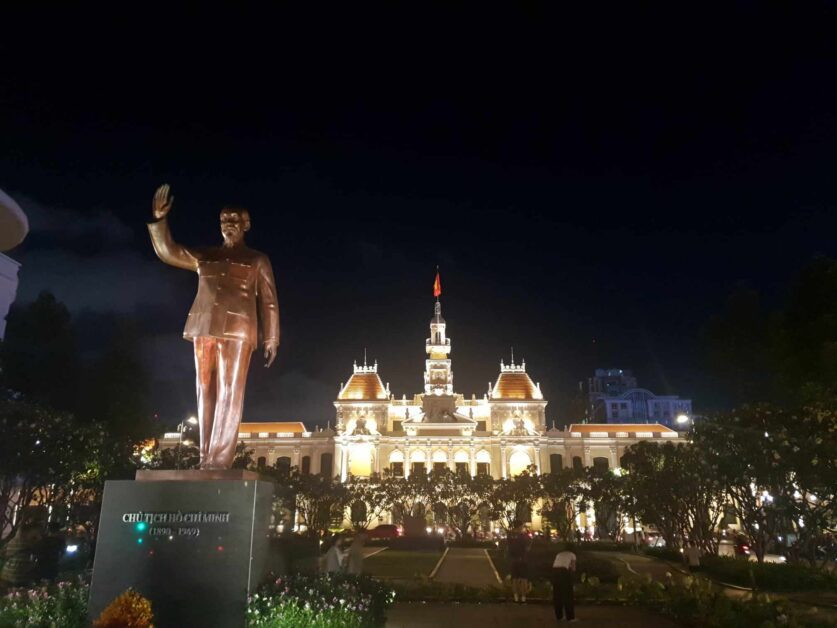
I wrote a bit about this in my article tackling a day trip to the War Remnants Museum but one of my favorite moments in the city occurred here. I was standing, taking in the gravity of it all, and saw a Vietnamese father with his son walk up next to me. I didn’t understand anything they were saying. But the father, with a serious and respectful demeanor, placed his hand on the son’s shoulder and began showing him different placards, exhibits, and photographs, clearly explaining the magnitude and sombreness of it all.
What was clear was that it was important to him that his son understood their history. This moment just struck me as a beautiful one as the imagery and descriptions showcased at the museum are heavy and tough topics to broach with anyone – let alone a young child. But from what I could tell, the father was doing so tactfully, respectfully, and in earnest education of his son.
Pale Ale Travel Tip: One common question I receive from friends, family, and even readers is whether you should refer to Ho Chi Minh City as ‘Saigon’ due to French colonial rule and of course certain political, social, and economic ideas and inequalities associated with that. To me, this seems to be very much a Western construct and concern, as almost everyone I’ve encountered while living in HCMC refers to it as Saigon and has stated that they only use the term ‘Ho Chi Minh City’ for administrative and official purposes.
Con: Humidity That is Off the Charts
What’s my name? Big Body. What do I do? Constantly sweat. Saigon has a tropical climate (more aptly referred to as a ‘tropical savanna’) which boasts an average humidity hovering around 80%. It’s divided into two seasons: dry and wet – with the latter lasting from May to November.
If you’re like my father, then you love hot and humid weather. However, if you were born and raised in a geographic region with more than two seasons, then this may take some getting used to.
When living in Saigon, I find myself taking showers upwards of two or even three times every day. Purchasing or using a humidifier is an absolute must if you have any specific clothes that you don’t want to lose to mold or you just don’t want to constantly feel “sticky” in your own apartment. The humidity of the city isn’t a non-negotiable for me but it sure does make some days tougher than others just to brave stepping out the door.
Pale Ale Travel Note: The rainy season is especially wild when it comes to flooding. As you have probably deduced by now, infrastructure is not the greatest. I’m a house cat most of the time so this isn’t a huge con for me. However, there’s a chance you may be far more active than me and like to make use of your days and want to see daylight, then the constant downpours, flooded roads, and overcast skies may be something to consider before moving.
Pro: Plenty of Western Amenities, Gyms, & Supermarkets
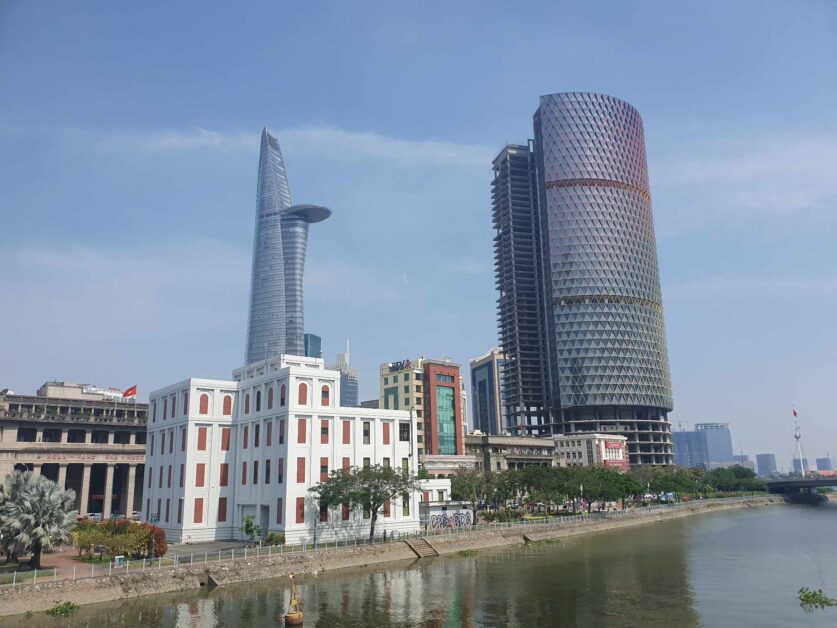
District 1 is a sure shot for anything Western you are in the mood for.
A pro and a con of living in Saigon is that it can be easy to get caught up in your own foreigner or expat bubble if you aren’t careful. A major contributing factor(s) is the abundance of Western amenities such as gourmet supermarkets, high-quality gyms, and international hospitals. If you’re looking for a French-speaking health clinic, you got it. If you want to be able to pick up gourmet Italian meats and cheeses, no problem. If you want a premium gym with all the fixings and quality equipment, you’re in for a treat.
A major reason why I love Saigon is that it’s incredibly comfortable for me to settle into a routine and enjoy the comforts of home.
Pale Ale Travel Note: I’ve been to both the foreign and local hospitals in Ho Chi Minh – with my most recent stint in Vietnam seeing me need to see a local ENT for strep throat several times. Honestly, it was a fantastic experience. The staff were polite, efficient, and attentive. My general feeling across the world is that the Western hospitals actually treat you far more as “cattle” and really aim to have you in and out the door as soon as possible so they can collect them dolla dolla billz y’all. So it was refreshing to feel heard and listened to by the staff at the local ENT clinic – both the doctor and nurse put me at ease, were thorough in their explanations and diagnostics, and were practical about how to treat my medical issue.
Con: May Feel Unable to Slow Down
Saigon can be an absolutely full-on city and it may feel like you never truly get a moment to catch your breath. There are lights, smells, sounds, and interactions that are addictive. There may be some internal volatility while you learn to stabilize and set mechanisms or safeguards in place to prevent yourself from going completely off the rails or being overwhelmed every single minute of the day.
After first moving there right after a breakup, I struggled with sitting by myself and the silence that came with it and instead got caught up in all the immediate gratification, festivities, and energy that was at my fingertips. It was only after several months of going full throttle that I eased up and took my foot off the gas, establishing a more sustainable (and healthy) routine. This con won’t apply to everyone of course but just something to be mindful of – as burning the candle at both ends can leave you emotionally, financially, and mentally depleted.
Pro: Overall Friendly & Curious Vietnamese Population
The Vietnamese are generally friendly people. Then again, I’m from New England where people aren’t exactly known for being warm, so maybe it doesn’t take too much for me to deem people as “friendly folk.” While a sentiment I’ve heard is that Vietnam may come off as overly “transactional” in most interactions, I would somewhat disagree.
Yes, there is a palpable wealth and income disparity that exists but if you treat anyone with respect, show that you are trying to speak a few words of Vietnamese (or more), and abide by local customs and cultural norms, then I would argue that you are going to walk out of more interactions than not with a pep in your step and smile on your face.
Even as someone who doesn’t speak the language, the people who became a part of my everyday routine when I lived in HCMC continually showed their true colors by offering me various treats, reciprocating my signature fist bumps, and even inviting me into their homes. Some of them I’m very proud to call friends and still spend time with to this day when I return (and have had several visit me across the world).
At the end of the day, my biggest piece of advice would be to learn the language or make an effort to learn even a few basic phrases – it really goes a long way towards making people feel comfortable, heard, and respected, and will open up social and emotional doors (both ways).
I remember one Tet (Lunar New Year), the motorbike guard outside of the cafe I’d frequented almost every day pulled me to the side, handed me some cigarettes and a half-empty bottle of whiskey, and we sat and smoked a few while we alternated pulls from the bottle and laughed. One of the baristas at that same cafe ended up becoming a great friend of mine and someone I still grab dinner with and hop around the city together when I’m back (for coffee, Mì Quảng, and some beers).
Pale Ale Travel Anecdote: A great memory (among others) that still replays in my head was the time I was waiting for a Grab at my apartment and the rider somehow got lost along the way. I asked the security guard of my building to hop on the phone to provide the driver with directions. Next thing I know, I hear the security guard howling with laughter and I see him take my phone over to the nearest chair where he sits down and proceeds to trade what I presume are jokes and life stories with the driver for the next 15 minutes. Data is so affordable in Saigon that I wasn’t even upset and just loved watching him in his element.
Con: Progress Seems to Be Slow
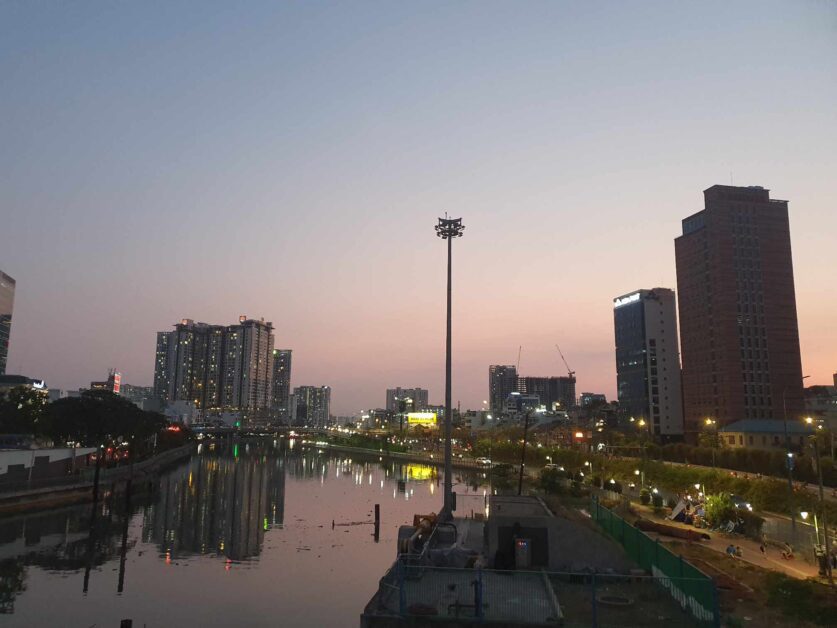
While there’s no doubt that Ho Chi Minh City (and its local government) has achieved a degree of success economically and socially over the past decade-plus, there’s still a glaring lack of progress when it comes to establishing sustainable and effective infrastructure, social and public services, bureaucratic efficiency, and remedying the wealth and income inequality that is rampant.
Corruption in Vietnam is ‘ubiquitous” and a part of everyday life. After all, it operates as an authoritarian single-party state with a relatively low score for “clean and honest” government practices in the public sector – which makes for a somewhat shaky climate to not only provide necessities to its constituents but also attract consistent and sustainable foreign direct investment.
I think for those planning on settling in Saigon for the long term, this all can lead to growing resentment and frustration that doesn’t ever fully allow you to feel “at home” or have a vested interest and/or stake in the community that you exist in. I know, at least for me, I do want to feel like the community or area that I settle permanently is on an upward trajectory or at least taking steps to remedy some of its glaring shortcomings. With that being said, no single place is perfect so if Saigon ticks the boxes for you in more positive ways than negative then I’d say it’s a darn good place to bet on for the long term.
Pro: Extremely Easy to Set Up a SIM & Affordable Data
Ho Chi Minh (and Vietnam) has great connectivity, boasting one of the fastest and most comprehensive mobile and internet networks in the region (there was a brief issue after an underwater cable went down at the beginning of 2023). Acquiring a SIM and Vietnamese phone number is a straightforward and affordable process that can be done as soon as you touchdown at the airport. Just remember to ensure that your phone is unlocked for international use.
Every time I land at Tan Son Nhat International Airport, I pick up a Viettel SIM card at the airport booth right before immigration. Simply provide your passport and hand over the requisite cash. It’s roughly USD $16 for your initial data package (roughly 10 GB) and SIM, which can then be easily topped up at your nearest convenience store. As someone who is on their phone frequently and tethers somewhat regularly for work, I run through about 250,000 dong (USD 10) worth of prepaid data per month for 4G. Monthly packages with Viettel can range from VND 90,000 (USD 3.70) for 1.5 GB of data per day (for 30 days) to VND 135,000 (USD 5.55) for 5 GB of data per day (also for 30 days).
Besides Viettel, the two other major cell and SIM card providers are Vinaphone and Mobifone. You can always purchase a SIM at an official carrier or location in the city as well (in case you’re jetlagged and forget at the airport).
If you don’t want to shell out for a SIM or are too lazy to top up sometimes like me, know that WiFi is readily available all over the city and there is rarely a cafe, restaurant, or mall that doesn’t have a workable connection.
For further reading on purchasing a SIM and data in Saigon, I recommend checking out this article by Vietnam Travel Tips. I also recommend checking out Viettel’s 4G packages here.
Is It Worth It to Live in Ho Chi Minh City?
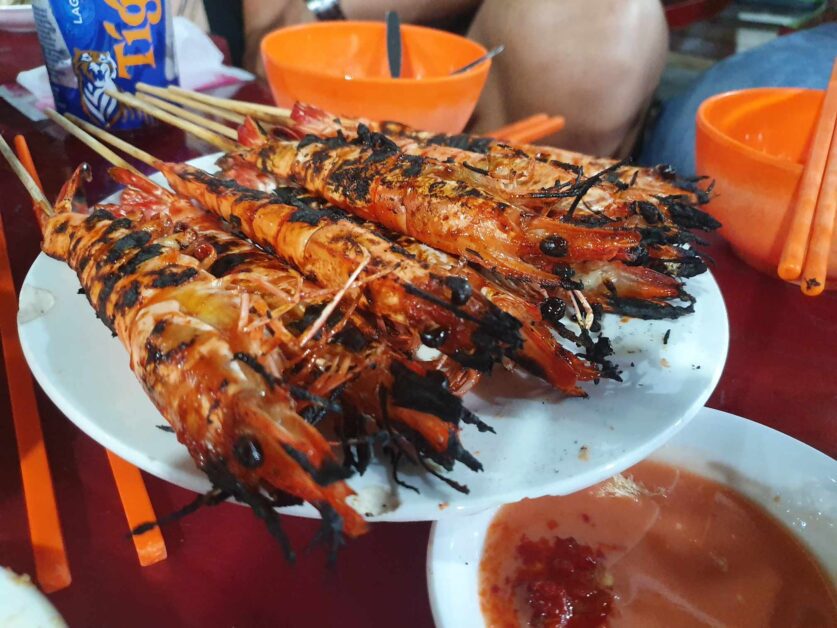
Wow. That turned into far longer than I thought it would. However, I think that’s a testament to just how much I love this city and can’t wait to be back for another extended period.
It is absolutely worth it to live in Ho Chi Minh City. It’s one of my favorite cities on earth. It’s raw, unrefined, resilient, growing, and comfortable. It’s one of the only other cities out there that I feel I can easily pick up and go to, settle into a routine without much hassle or stress, be surrounded by friends, and live on my own terms. It’s also the most alive I’ve ever felt. I know for some, this is also what makes it unpalatable for them, so it really is a “to each his own” type of deal with this city.
At this point, HCMC is just part of my life. It always will be (to some degree). It’s a complete 180 from when I first landed in Saigon, was in the Grab over to my friend’s apartment (where I was staying for the first week), and had this gut feeling that I made a mistake and would leave within one month. After I set up shop with an apartment, found a gym in the vicinity, and reconnected with some old friends, I didn’t want to leave.
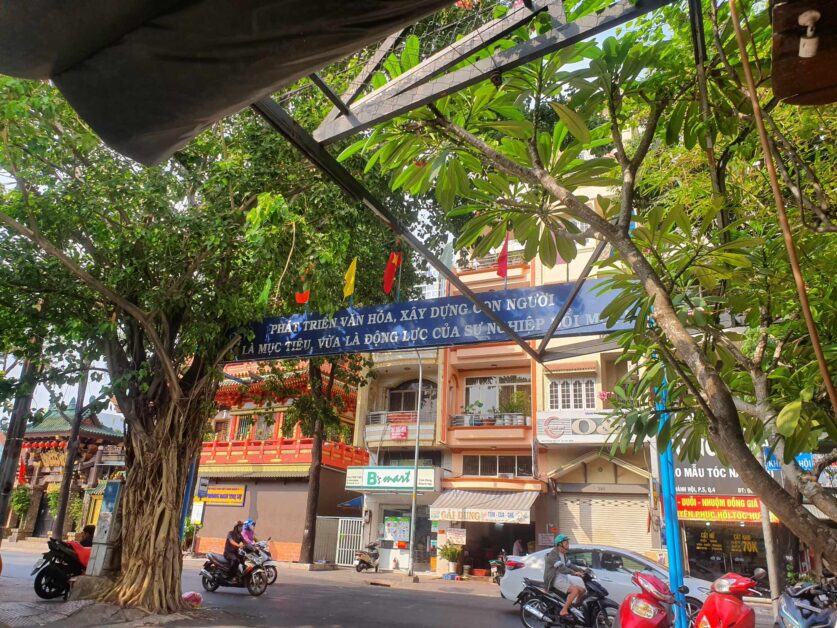
Picture of an alley in District 4 (my home district) that I love posting up at with a coffee.
What actually was the major impetus behind my leaving was some bad shellfish I ate at a Hawaiian restaurant on Bui Vien Street that ultimately devolved into a gastrointestinal bacterial infection (I’ll write about this at some point because it was actually a hilarious and interesting experience).
If you’ve lived in Saigon (or traveled to the city), I’d love to hear your thoughts on what it was like and if you loved and/or hated it. Feel free to let me know in the comments or via email (info@palealetravel.com). Or, if you have any questions about moving to the city, please don’t hesitate to reach out and I’d be more than happy to answer them!
Stay well everyone,
Big Body
Big Body is a voracious lov…eater, a cowardly fighter, and a self-proclaimed curry goat BBQ-eating champion (don’t forget the donkey milk) who likes Stoicism, baseball, and writing in the third person. Having worked for himself for the last 7 years, he isn’t particularly successful but he does still drink ice-cold Sapporo draft beers with the best of them and knows his way around a Dai Pai Dong or two. He is based in Hong Kong but you can still find him in Saigon, Osaka, and Vienna for extended periods.
